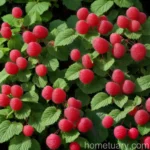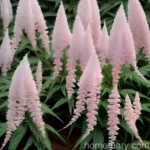Red Raspberry (Rubus idaeus ‘Heritage’)
In this comprehensive guide, we will explore the world of red raspberries with a focus on the ‘Heritage’ variety (Rubus idaeus ‘Heritage’). The red raspberry is a popular and delicious addition to any garden, and the ‘Heritage’ variety, in particular, is known for its exceptional flavor and disease resistance. Whether you are a seasoned gardener or a beginner, this guide will provide you with all the information you need to successfully grow, care for, and enjoy red raspberries in your own garden.
What is a Red Raspberry?
The red raspberry, scientifically known as Rubus idaeus, is a deciduous perennial fruit-bearing plant that belongs to the Rosaceae family. This plant is native to Europe and northern Asia but is now extensively cultivated in many regions of the world for its delicious and nutritious berries. The ‘Heritage’ variety, in particular, has gained popularity for its high yields, excellent flavor, and disease resistance.
Key Takeaways – Red Raspberry (Rubus idaeus ‘Heritage’)
Before delving into the specifics of growing and caring for red raspberries, it is essential to understand the key characteristics and requirements of the ‘Heritage’ variety. Here are some key takeaways:
-
Heritage Raspberry Plant: The ‘Heritage’ raspberry plant is a perennial deciduous shrub with exceptional disease resistance and high fruit yields.
-
Rubus idaeus Heritage: This refers to the botanical classification of the ‘Heritage’ raspberry within the Rubus idaeus species.
-
Red Raspberry Variety: The ‘Heritage’ variety is known for its bright red, juicy, and flavorful berries.
-
Raspberry Plant Care: Proper care and maintenance are crucial for ensuring the healthy growth and fruiting of red raspberry plants.
-
Growing Red Raspberries: Understanding the ideal growing conditions and practices is essential for a successful raspberry harvest.
-
Cultivating Rubus idaeus: The cultivation of Rubus idaeus, especially the ‘Heritage’ variety, requires attention to specific cultural practices.
-
Raspberry Plant Propagation: Knowing how to propagate red raspberry plants allows for the expansion of raspberry patches or the sharing of plants with others.
-
Heritage Raspberry Facts: Familiarize yourself with interesting facts and characteristics of the ‘Heritage’ raspberry variety.
-
Red Raspberry Disease Resistance: The ‘Heritage’ variety exhibits resistance to certain raspberry diseases, making it an attractive option for growers.
-
Harvesting Heritage Raspberries: Proper techniques for harvesting red raspberries ensure maximum yield and flavor.
Let’s explore each of these aspects in detail to gain a comprehensive understanding of how to cultivate and care for red raspberries, specifically the ‘Heritage’ variety.
Culture
Cultivating red raspberries, including the ‘Heritage’ variety, involves understanding the plant’s cultural requirements and adapting to specific conditions for optimal growth and fruit production.
Water
Watering Requirements: Red raspberries, including the ‘Heritage’ variety, require consistent and adequate moisture, particularly during the fruiting season and dry spells. However, it is crucial to avoid waterlogged conditions, as this can lead to root rot and other moisture-related issues.
Irrigation Methods: Drip irrigation or soaker hoses are excellent methods for delivering consistent moisture to raspberry plants while minimizing water wastage.
Signs of Overwatering: Yellowing leaves, wilting, and damping off are indicators of overwatering, while under-watered plants may exhibit wilting and a decline in fruit production.
Sunlight
Sun Exposure: Red raspberries, including the ‘Heritage’ variety, thrive in full sun to partial shade. However, they produce the best fruit yields and quality in areas with ample sunlight.
Ideal Conditions: Select a planting site that receives at least 6 hours of direct sunlight daily for optimal raspberry growth and fruiting.
Shade Protection: In regions with intense summer heat, providing partial shade during the hottest part of the day can protect the plants from stress and sunburn.
Fertilizer
Nutritional Requirements: Red raspberry plants have specific nutritional needs that can be met through proper fertilization.
Balanced Fertilizer: Apply a balanced fertilizer in early spring before new growth begins, following the manufacturer’s recommendations for application rates.
Organic Amendments: Incorporating well-rotted compost or organic matter into the soil can provide essential nutrients and improve soil structure.
Avoid Over-Fertilization: Excessive fertilization can lead to rapid but weak growth, making the plants more susceptible to diseases and environmental stresses.
Soil
Soil Type: Red raspberries, including the ‘Heritage’ variety, prefer well-draining, loamy soil with a slightly acidic to neutral pH.
Soil Amendments: Incorporate organic matter such as compost or well-rotted manure into the soil to improve its texture and fertility.
Soil Moisture: Consistent soil moisture is vital for the healthy growth of raspberry plants, but they are intolerant of waterlogged conditions.
Raised Beds: In areas with heavy or poorly draining soil, consider planting red raspberries in raised beds to improve drainage.
Pruning
Pruning Objectives: Proper pruning is essential for maintaining the health, vigor, and productivity of red raspberry plants.
Annual Pruning: Perform annual pruning during the dormant season to remove old canes, encourage new growth, and improve airflow within the plantings.
Pruning Techniques: Use sharp, clean pruners to make precise cuts, ensuring the removal of dead, diseased, or weak canes while retaining healthy and vigorous ones.
Training Systems: Consider using trellises or support systems to train raspberry canes, making it easier to manage and harvest the plants.
Propagation
Vegetative Propagation: Red raspberries, including the ‘Heritage’ variety, can be propagated through division, layering, or cuttings.
Division: Divide established raspberry patches by carefully separating and transplanting the root mass into new planting areas.
Layering: Encourage the development of new plants by allowing raspberry canes to bend to the ground and root at the nodes.
Cuttings: Root cuttings can be taken from healthy raspberry canes to start new plants, ensuring that each cutting has several nodes and is taken from vigorous growth.
Container Popularity
Red raspberries, including the ‘Heritage’ variety, are increasingly being grown in containers, allowing gardeners with limited space to enjoy these delicious fruits.
Container Selection: Choose large, sturdy containers with excellent drainage to accommodate the extensive root system of raspberry plants.
Soil Mix: Use a well-draining potting mix enriched with organic matter to provide ample nutrients and moisture for container-grown raspberries.
Sunlight: Place the containers in a location with at least 6 hours of direct sunlight per day to promote healthy growth and fruiting.
Watering: Container-grown raspberries may require more frequent watering than those in the ground, as the soil can dry out quickly in containers.
Common Diseases
Red raspberries, including the ‘Heritage’ variety, are susceptible to several diseases that can impact plant health and fruit production.
Disease Diagnosis
Anthracnose: Identify anthracnose by the appearance of small purple spots on the fruit, eventually leading to sunken lesions and fruit rot.
Botrytis Fruit Rot: Gray mold on fruit and canes, particularly during wet conditions, indicates botrytis fruit rot.
Powdery Mildew: A white powdery growth on the leaves and canes is characteristic of powdery mildew infection.
Phytophthora Root Rot: Wilting, yellowing, and stunted growth can indicate the presence of phytophthora root rot, particularly in waterlogged or poorly drained soil.
Septoria Leaf Spot: Circular, dark lesions with a light center on raspberry leaves are signs of septoria leaf spot infection.
Common Pests
Red raspberries, including the ‘Heritage’ variety, are vulnerable to insect pests that can damage foliage and fruit if not managed effectively.
Japanese Beetles: These metallic green beetles feed on raspberry foliage and can significantly impact plant health and vigor.
Spider Mites: Fine webbing on the undersides of leaves and stippled discoloration are indicative of spider mite infestations.
Raspberry Fruitworm: Look for damaged fruit with small entry holes, suggesting the presence of raspberry fruitworms.
Aphids: Colonies of small, soft-bodied insects on new growth and buds are signs of aphid infestations.
Botanist’s Tips
Disease-Resistant Varieties
When selecting raspberry cultivars for planting, prioritize disease-resistant varieties such as the ‘Heritage’ raspberry to minimize disease management efforts and promote plant health.
Mulching
Apply a layer of organic mulch around raspberry plants to conserve moisture, suppress weed growth, and maintain more consistent soil temperatures.
Integrated Pest Management (IPM)
Adopt an integrated approach to pest management, including physical, cultural, and biological control methods before resorting to chemical treatments.
Crop Rotation
Rotate raspberry plantings to different areas of the garden every few years to reduce the buildup of soil-borne diseases and pests.
Timely Harvesting
Harvest ripe red raspberries regularly to prevent over-ripening, which can attract pests and lead to a decline in fruit quality.
Fun Facts
- The ‘Heritage’ raspberry was developed in New York State and is prized for its exceptional flavor and hardiness.
- Red raspberries are not true berries but are classified as aggregate fruits, composed of multiple smaller drupelets.
- Raspberries are an excellent source of dietary fiber, vitamins C and K, and antioxidants, making them a nutritious addition to your diet.
Links to External Resources
- University of Maine Cooperative Extension – Growing Raspberries in Maine
- North Carolina State University – Plant Disease and Insect Clinic
- University of California – Integrated Pest Management for Raspberries
- National Sustainable Agriculture Information Service – Raspberry Production Guide
In conclusion, the ‘Heritage’ red raspberry (Rubus idaeus ‘Heritage’) is a delightful and rewarding addition to any garden. With the right cultural practices, care, and attention to disease management, you can enjoy a bountiful harvest of delicious raspberries each season. Whether you are a home gardener or a commercial grower, the ‘Heritage’ raspberry is a versatile and sought-after variety that is sure to delight with its abundant fruit and exceptional flavor.















